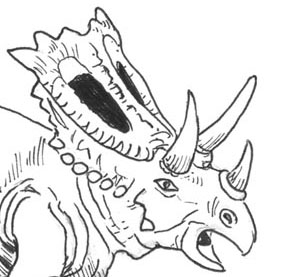Bravoceratops polyphemus – New Horned Dinosaur Discovery Announced
A new species of large chasmosaurine dinosaur has been announced, this new member of the horned dinosaurs has been named Bravoceratops polyphemus and it lived in what is now Texas between 72 and 70 million years ago (Maastrichtian faunal stage of the Late Cretaceous). Chasmosaurines were one of two groups of advanced horned dinosaurs. In general, they had long neck frills and the brow horns were usually bigger than the nose horn, perhaps the most famous member of the Chasmosaurinae is the Triceratops genus.
New Species of Horned Dinosaur
The fossil material, which includes fragments from the giant skull were found in the lower layers of the Javelina Formation of Texas (United States). Ceratopsian fossils from this portion of the Javelina Formation are rare, although fossils of Torosaurus, a later chasmosaurine have been found in upper layers of this particular series of strata. The fossils show extensive weathering, this suggests that much of the material was exposed to weathering before burial and fossilisation, only the most robust elements of the skull and horns have survived as fossils.
The skull may have become disarticulated prior to fossilisation, the research team who discovered this new specimen, back in 2011, found that the pieces of skull were scattered over a ten metre square area.
The holotype material was found at the “Hippiewalk” site, north-east of Paint Gap Hills in the Big Bend National Park. The fossils were studied by palaeontologists from the United States National Park Service and Texas Tech. University. This dinosaur was named and described by Steven Wick (Division of Science and Resource Management – Big Bend National Park) and Tom Lehman (Department of Geosciences, Texas Tech). The genus name – Bravoceratops means “wild horn face”, named after the Rio Bravo del Norte which marks the border between Mexico and the National Park.
Bravoceratops polyphemus
The term “Bravo” comes from the Spanish meaning “wild”. The species name is derived from the Greek cyclops called Polyphemus, a one-eyed monster. In the skull material there is a “socket” shape to be found in part of the bones that form the back of the head, this is believed to have been an attachment area for a protruding bony epoccipital. A paper on this new dinosaur has been published in the academic journal “Naturwissenschaften”,which incidentally, celebrates its 100th anniversary this year.
An Illustration of the Chasmosaurine B. polyphemus
Picture credit: Everything Dinosaur
Fragmentary Material
Although known from only fragmentary and very weathered material, scientists estimate that this was one of the largest of the horned dinosaurs with a skull in excess of 2.2 metres in length, and brow horns nearly one metre long. It may have been as large as Triceratops horridus, perhaps measuring more than nine metres in length and weighing seven tonnes. This dinosaur is not to be confused with the much smaller and more primitive ceratopsians from Asia known as Bagaceratops and Breviceratops.
The discovery of B. polyphemus comes at a time when the authorities at the Big Bend National Park are developing a permanent Cretaceous-themed exhibit to showcase some of the prehistoric animal discoveries that have been found within the Park’s borders. It is hoped that a full-sized cast of the skull of Bravoceratops will form part of the dinosaur display.
B. polyphemus although very similar in appearance to a number of Late Cretaceous chasmosaurines, can be distinguished by its long, narrow snout, the substantial frill with large openings in bone (fenestrae) and several skull bone characteristics including a series of bony projections from the back of the skull (parietal bone).
To view several horned dinosaur models available in the CollectA Prehistoric Life, not-to-scale model range: CollectA Prehistoric Life/Prehistoric World Figures.






Leave A Comment